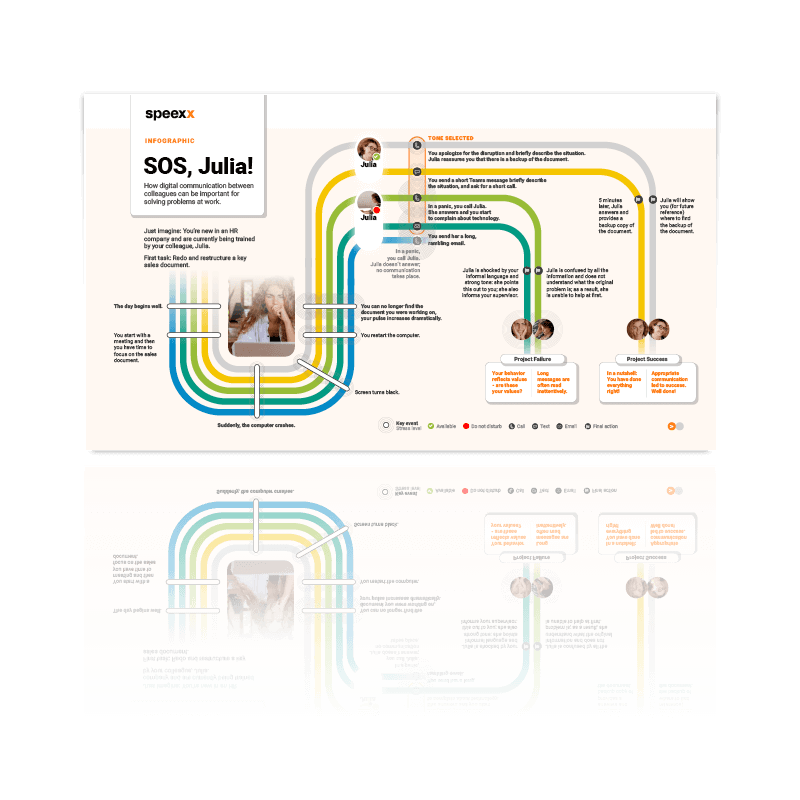You would be forgiven if the term asynchronous communication left you scratching your head, but you are almost certainly communicating asynchronously all the time.
Asynchronous is a fancy-sounding way to describe any communications sent without the anticipation of an immediate comeback; typically, this would be via SMS, email, or other messaging platforms. In a work context, the norm has generally been to favor synchronous (direct and instant) interactions; however, the asynchronous approach has proven to boost team productivity, enhance decision-making processes, and elevate the visibility of significant projects across various team functions. Effective use of both synchronous and asynchronous communication is vital to the smooth running of any successful team. This article explores the role of asynchronous communication in today’s workplace, where it fits with synchronous communication, and how to strike the right balance between the two means of communication.
Contents
Asynchronous Communication or Synchronous Communication?
Asynchronous
The shift towards hybrid and remote working models has given rise to a new way of working where asynchronous communication is now standard. Receiving alerts in the middle of the night, once considered inappropriate, has now become the norm as teams are more geographically dispersed. The distinction between asynchronous and synchronous lies in the expectation of a response; sending an email to a colleague who is fast asleep in another time zone is acceptable with the understanding that they are not expected to reply right away.
Synchronous
Synchronous communication demands an immediate reply and is characterized by real-time interactions, often conducted in person. Imagine initiating a conversation with someone who does not respond, the lack of response would generally be considered inappropriate or rude.
Asynchronous Communication Promotes Quality of Work
Asynchronous communication provides team members with an environment in which to concentrate on their core tasks. This framework enables the fulfillment of critical objectives and the achievement of milestones with minimal interruptions and more focused efforts. Although simple, the significance of this style of communicating is profound, as it offers a substantial impact on the efficacy of work, particularly in remote settings where concentration can be optimized. Many workers often achieve their highest quality of work in environments that allow for focused attention, away from the immediate demands of synchronous meetings.
Sync or Async: Modern Apps Bridging Gaps
Asynchronous communication bridges gaps in time and geography, where immediate interaction between both parties is not always feasible. Even in more traditional work settings, asynchronous communication forms the backbone of daily professional exchanges. Modern day tools and platforms support collaborative efforts without the need for simultaneous presence. Collaborative platforms like Monday.com and Wrike, as well as video messaging apps such as Teams and Loom that can be accessed at any time, and provide detailed status reports, accommodating diverse schedules and working conditions.
Most of these apps can also be used for synchronous – or real-time – communication, allowing for instant exchanges between colleagues. Collaborative sessions can happen both remotely or in physical presence, or conversations over digital platforms like Zoom or Slack. This mode ensures that responses can be given and received on the spot.
When comparing asynchronous to synchronous communication, neither one is universally preferable over the other; both have their pros and cons and are suitable for different scenarios. Let’s explore the strengths and weaknesses inherent to both communication methods.
Advantages of Asynchronous Communication
- Supports the state of deep concentration and flow because – if managed effectively – team members spend less time in meetings, giving them more opportunity to focus deeply on their tasks.
- Particularly advantageous for distributed teams across different time zones, where synchronizing communication can be difficult. Asynchronous communication ensures everyone receives the necessary information in a timely and convenient manner.
- Ensures that all communication is recorded. Whether it’s through written communication or using project management tools, having a record of all exchanges simplifies the process of reviewing discussions or project specifics later on.
- Promotes more detailed and clearer communication. Having the time to contemplate allows team members to refine their messages for clarity and completeness.
- Often leads to better solutions. Allowing team members to contemplate issues individually gives them the chance to develop more thoughtful and effective solutions.
- Enables team members to work during their most productive hours, whether that’s early in the morning or later in the afternoon, thus maximizing individual productivity and output.
Challenges of Asynchronous Communication
Despite its numerous advantages, asynchronous communication is not without its challenges, here are some:
- Time delays can complicate matters depending on the message’s nature or its intended outcome.
- Writing takes time! Crafting detailed messages requires a notable investment of time.
- Information silos can obscure clarity and accessibility. When communication tools are fragmented, it can become challenging for team members to locate necessary information or collaborate effectively.
- A diminished sense of connection among team members is another drawback. Incorporating regular team-building exercises can mitigate this.
- It’s easy to miss the subtleties conveyed through face-to-face interaction, which can be pivotal in discussions needing nuance, such as appraisals or conflict resolution. Opting for live discussions in these scenarios can help bridge the understanding gap.
Now let’s take a look at some of the most commons pros and cons of synchronous (real-time) communication.
Upside of Real-time Communication
- Immediate resolution of issues is a clear strength of real-time communication, ideal for addressing urgent matters or finding solutions on the spot.
- It enhances direct communication, especially important for discussing sensitive subjects or offering constructive feedback, minimizing misunderstandings.
- It strengthens bonds among team members through regular, personal interactions, which are essential for team morale and individual career development.
- Encouraging collective brainstorming and creativity, real-time discussions can spark innovative ideas and foster a collaborative spirit within the team.
Drawbacks of Real-time Communication
- Frequent meetings can disrupt work momentum, breaking concentration and hindering individual productivity.
- Meetings often lack a defined objective, leading to potentially unnecessary gatherings that could have been communicated via messaging or email.
- Important ideas and tasks discussed in meetings may get overlooked or forgotten, especially if not documented properly.
- Hasty decision-making can occur, with some team members possibly making quick calls without fully processing the available information or considering alternatives.
The 30-minute Threshold
Recent studies conducted by Dr. Sahar Yousef, a cognitive neuroscientist at UC Berkeley, indicate a significant drop in meeting productivity after reaching the 30-minute threshold. Dr. Yousef states:
“We discovered that after the 30-minute mark of a video call, the brain experiences excess fatigue, making it very difficult to concentrate. If you must schedule longer meetings, or blocks of meetings, make time for a 1-minute break at the 30-minute mark. It’ll really help your brain reset and maintain energy for the next 30 minutes.”
8 Tips for Successful Asynchronous Communication in the Workplace
Asynchronous communication – when it is used effectively and combined with real-time communication – can significantly boost productivity, allow more focused work periods, and empower teams to prioritize their most urgent tasks. At Speexx, the value of asynchronous communication in elevating productivity and minimizing redundant tasks is well acknowledged. For any organizations that are new to this way of working, here are eight foundational tips to consider when setting up a structured approach to asynchronous communication.
- Draft a Communication Strategy
Provide clear guidelines on which channels to use for specific types of messages, when to prefer asynchronous over synchronous communication, how and when to share key project updates, and expected response times for various projects. At Speexx, this includes using both in-person and digital tools like Wrike for asynchronous work discussions and Teams for immediate queries.
- Use a Shared Digital Workspace
Optimize team collaboration by ensuring all project information is centralized. This approach helps to reduce information silos and improve visibility on who is doing what and by when. At Speexx we use SharePoint, but there are plenty of other platforms that serve the same purpose.
- Use Meetings Strategically
Meetings are one of the trickiest parts of remote work setups to get right and so deserve special attention. While synchronous meetings help maintain cohesion within teams spread across the globe, they should always have a clear agenda and purpose to prevent time-wasting. Set clear expectations on what warrants a meeting and what can be communicated asynchronously; simple updates often work just as well – or even better – than a meeting with no clear purpose. It can also be useful to implement a no meeting day, like No Meeting Wednesday, to give team members time for focused, uninterrupted work.
- Share Working Hours
Invite team members to share their schedules – especially in remote setups – to establish clear expectations around availability and response times.
- Schedule Dedicated Focus Times
Emphasize the importance of muting notifications and batching meetings to allow for deep, undisturbed work periods.
- Voluntary Meetups
Create opportunities for real-time interaction among remote team members to foster a sense of community and mitigate feelings of isolation. This could be through regular video check-ins or casual team chats that are open to those who want to join.
- Establish Guidelines
Provide clear examples of what types of communication are best handled in real-time or asynchronously to help team members make informed decisions about how to communicate most effectively.
- Keep Meetings Concise
Ideally, video meetings should be kept to under 30 minutes to maintain engagement and productivity. Introduce breaks for longer meetings to help participants stay focused.

Digital Communication Among Colleagues
A code of conduct in the cyber workspace.
Get the document

Key Takeaways
Remote and hybrid work models significantly influence the adoption of asynchronous communication, with remote teams tending to lean towards asynchronous methods. However, this approach is not limited to remote settings; it can enhance productivity in any work environment, including traditional office settings or virtual meetings via platforms like Zoom.
For leaders of remote teams, it is crucial to find a balance between the predominantly asynchronous conversations with opportunities for direct, face-to-face interactions. This balance helps remote employees feel more integrated and connected with their team.
Adopting an asynchronous communication model can substantially benefit your team, enabling efficient work processes, fostering better decision-making, and improving the overall transparency and accessibility of crucial project information. This method not only streamlines workflows but also facilitates the sharing of ideas and information across different team functions.


